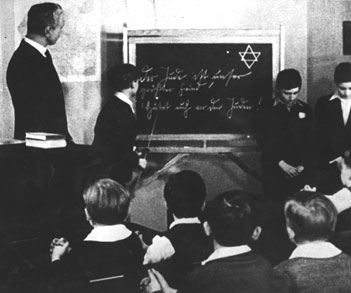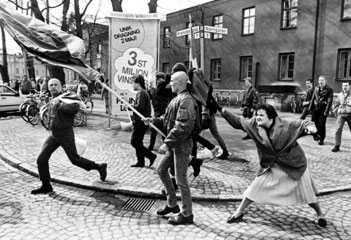Interactive Lecture
Almost all of us encounter situations fairly regularly in which somebody is treated unfairly. When we become aware of this, we choose how to respond. Too often, for a variety of reasons, we decide to not get involved. On other occasions, we discover that the actions we took were not the appropriate ones. Nazi Germany provides a compelling example of how people made different decisions about how to treat those who were different in some way. This lesson helps students reflect on what they can do when they encounter unfair treatment. These are decisions they will need to make throughout their lifetimes.
Upon completion of this lesson, students will be able to:
1. Understand that there are different ways to deal with rights abuses and unfair treatment.
2. Understand the distinction between perpetrators, bystanders, victims, and helpers.
3. Understand and discuss with each other strategies to combat intolerance with each other.
SHOW ME STANDARDS
2. Continuity and change in the history of Missouri, the United States and the world
6. Relationships of the individual and groups to institutions and cultural traditions
7. The use of tools of social science inquiry (such as surveys, statistics, maps, documents)
KANSAS STANDARDS (High School-US History)
Benchmark 5: The student engages in historical thinking skills.
1. (A) analyzes a theme in United States history to explain patterns of continuity and change over time.
2. (A) develops historical questions on a specific topic in United States history and analyzes the evidence in primary source documents to speculate on the answers.
4. (A) compares competing historical narratives in United States history by contrasting different historians’ choice of questions, use of sources, and points of view, in order to demonstrate how these factors contribute to different interpretations.
KANSAS STANDARDS (High School-World History)
Benchmark 3: The student uses a working knowledge and understanding of individuals, groups, ideas, developments, and turning points of the Era of World War (1914-1945).
3. (A) examines the nature of totalitarianism in fascist Germany and communist Soviet Union (e.g., one party rule; systematic violation of human rights, secret police, state supremacy over individual rights, role of private property, class structure).
"The Roles People Play" handout
Additional teacher information on the two (2) photos
Photos:Photos and part of lesson taken from: Contemporary Holocaust Education Foundation, Inc. ©2001
Day one
Class Activities/Independent Practice (student): Distribute a copy of the two (2) photos. Each student individually spends 15 minutes writing two (2) paragraphs (one paragraph for each photo) answering the question: "What happened next?" Students should try to answer as realistically as possible. When writing the narrative, they must focus on what is happening in the photo. Once completed, students are placed in groups of four (4). Each student summarizes his/her essay for the others. The group discusses which of the four (4) scenarios is the most likely and why.
Guided Practice (instructor/student): The instructor debriefs the students and provides some background information on both situations.
Day two
Class Activities/Independent Practice (student): Students are again given the photos and are placed in groups of four (4) (can be different or same groups). They must now, in groups, address the following questions for each photo and create on a large sheet of paper the following columns for each photo:
| Most effective options | Why | Least effective options | Why |
Photo 1:
 |
| Initially, Jewish children go to the same schools as other German children. These two Jewish children are being humiliated in front of the classroom. The text on the blackboard reads: "The Jews are our greatest enemy! Beware of Jews." |
What do you think would happen in your school if students were ridiculed like this? Who would be responsible for taking actions? Which options are there for action? Which options would be the least and most effective? Why?
Photo 2:
 |
| A Neo-Nazi march in Sweden. Is this woman doing "the right thing"? What risks is she taking? Are anybody’s rights being violated here, and if so, which rights? Whose? What other ways could she protest against these Neo-Nazis marching through her town? |
The woman in the photo has decided to take action. Is she taking a risk? Is she doing the "right thing?" What other options did she have in this situation? What would happen in our community if such a Neo-Nazi march would take place? Which options are there for action? Which options would be the least and most effective? Why?
Each group presents its list of least and most effective options.
Guided Practice (instructor/student):
The instructor debriefs the students about the consequences of choices, then and now. People can decide to get involved (in different ways) or not to get involved. This is rarely an easy decision. Each decision has consequences and the correct decision is not always clear.
The roles people play
Perpetrator -- Perpetrators are those people responsible for harm done to other people.
Victim/survivor -- Victims or survivors are those who suffer due to discrimination, racism, and violence. Many people who have suffered at the hands of others prefer to be called survivors rather than victims. If someone managed to live through the horrors of the Holocaust, we call them Holocaust survivors. A survivor need not be someone who was in a concentration or extermination camp. Many were persecuted because of their beliefs. Others went into hiding. Some simply survived the whole ordeal.
Helper -- A helper is a person who comes to the aid of another person who is being threatened in some way.
Bystander -- A bystander is a person who does not get involved or does not intervene when someone else is being harmed or threatened in some way.
Photos and part of lesson taken from: Contemporary Holocaust Education Foundation, Inc. ©2001

